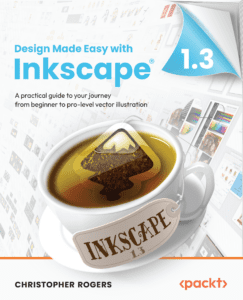Christopher Rogers is the author of Design Made Easy with Inkscape; we got the chance to sit down and find out more about his experience of writing with Packt.
Q: What is the name of your book?
Christopher: Design Made Easy with Inkscape
Q: What are your specialist tech areas?
Christopher: Graphic design, product design, 3D modeling, animation, video & web design.
Q: How did you become an author for Packt? Tell us about your journey. What was your motivation for writing this book?
Christopher: I was approached by Packt to write this book about Inkscape. I had plans to write such a book previously, and the offer to work directly with a great company like Packt was just the push I needed to get started. My motivation for writing the book is to be able to offer an extremely detailed and high-quality tour of Inkscape’s functionality, with real-world graphics example projects, based on my many years of using Inkscape as a professional production tool. I also wanted to make something of high value for watchers of my free tutorial videos to buy to help support my work and get something of great educational value in return.
Q: What kind of research did you do, and how long did you spend researching before beginning the book?
Christopher: I spent ten years using Inkscape in production, and five years helping add and refine features in Inkscape for a graphics workflow as part of the project.
Q: Did you face any challenges during the writing process? How did you overcome them?
Christopher: The biggest challenge was time. Since I hand-designed all the graphics for the book, I wanted to make sure that the diagrams were not only of high quality but also very clear. I overcame these obstacles by developing a general style for the diagrams in my book and leveraging Inkscape’s advanced features to help me produce high-quality, consistent diagrams at a much faster rate.
Q: What’s your take on the technologies discussed in the book? Where do you see these technologies heading in the future?
Christopher: Having been part of each major release of Inkscape in recent times, I can say that the future is quite bright for Inkscape. We’re building internal administrative structures that will help more people join the project, reduce development time for new features, and address and fix bugs for much more stable releases than we’ve had in the past (which were pretty stable anyway).
Q: Why should readers choose this book over others already on the market? How would you differentiate your book from its competition?
Christopher: The sheer quantity and quality of my diagrams along with my industry experience makes this book a great fit for users of Inkscape, regardless of experience. My many many years of answering user questions on the forums have given me a great insight into where people get “stuck” when learning the software, and my book addresses these sticking points, with a best-practices approach to getting your work done faster and better by leveraging little known features of Inkscape. It is thus a high-value item for both new and pro-Inkscape users.
Q: What are the key takeaways you want readers to come away with from the book?
Christopher: Having read this book and worked through the sample exercises, they will know how to use all of Inkscape’s main tools and features, including the brand-new ones added in Inkscape 1.3. They will be able to confidently and expertly use Inkscape to make anything they desire, and discover chapter by chapter what Inkscape can do for their creativity and projects, all while preserving and respecting their freedoms, for free!
Q. What advice would you give to readers jumping into this technology? Do you have any top tips?
Christopher: My advice would be to read through the materials, and take your own notes for those features you find most useful for your projects. Also, work through the practice lessons completely. If you get stuck somewhere, feel free to reach out on one of the various Inkscape forums. Even if I’m not there to answer right away, there is a huge and friendly community of Inkscape users, who, like me, love to help people learn Inkscape.
Q. Do you have a blog that readers can follow?
Christopher: My blog can be found on my main freelance website: www.crogersmedia.com
Q: Can you share any blogs, websites, and forums to help readers gain a holistic view of the tech they are learning? What are the key takeaways you want readers to come away with from the book?
Christopher: Really, the best way to learn Inkscape is through practice with your own projects, using resources like this book, and also asking questions in one of Inkscape’s social media forums (Facebook is currently one of the largest).
Here is one: https://www.facebook.com/groups/inkscape.org
Q. How would you describe your author’s journey with Packt? Would you recommend Packt to aspiring authors?
Christopher: It was a long process, especially producing all the diagrams, but I’ve found the Packt folks to be highly knowledgeable, professional, and understanding. I’m frankly amazed at their attention to detail, professionalism, and availability to answer any questions I had during the process, and dealing with my perhaps overly picky designer’s preferences for my book.
Q. Do you belong to any tech community groups?
Christopher: I’m active in many Linux groups on Facebook, and am currently expanding my social media presence.
Q. What are your favorite tech journals? How do you keep yourself up to date on tech?
Christopher: Generally youtube videos.
Q. How did you organize, plan, and prioritize your work and write the book?
Christopher: Via spreadsheet formulas to estimate page count vs delivery time, and gentle pushes from the great folks at Packt, and my friends and family.
Q. What is that one writing tip that you found most crucial and would like to share with aspiring authors?
Christopher: Always follow your diagrams and sections with a “signpost” summary to help with information retention, and to introduce the next section. It gives the reader a nice place to take a break and makes the transition from one topic to another smoother and more enjoyable.
Q. Would you like to share your social handles? If so, please share.
Christopher: Facebook | Mastodon | Youtube | Instagram | LinkedIn | Patreon
You can find Christopher’s book on Amazon by following this link: Please click here









